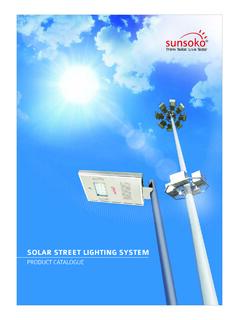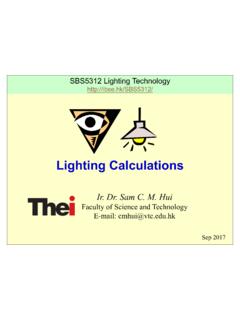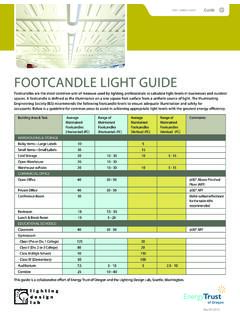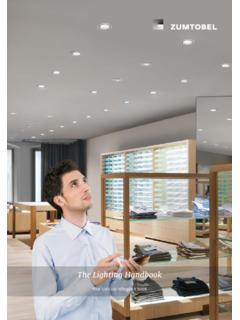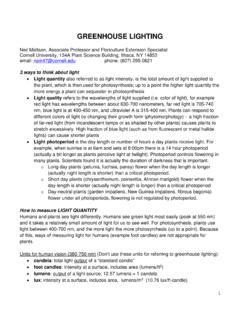Transcription of Industrial lighting Final - Bajaj Electricals
1 ContentsINTRODUCTIONSURFACE/PENDANT MOUNTING FTL LUMINAIRESWELL GLASS LUMINAIRESLOW BAY LUMINAIRESCANOPY lighting LUMINAIRESHIGH BAY AND MEDIUM BAY LUMINAIRESBULK HEAD LUMINAIRESTECHNICAL & COMMERCIAL DETAILS1-89-1112-1417-1825-2615-1619-242 7-28 TMFlux emitted by luminaire x 100%No. of Lamps in a luminaire x nominalflux of one lampTotal Output Ratio(or efficiency)=IntroductionThe function of interior illumination is to provide human beings with an environment which contributes to their mental and physical well-being and prevents accidents. In addition, it should influence the mental state of the persons involved with the aim of achieving a higher degree of performance, combating premature fatigue and reducing errors.
2 The choice of the right type of light sources and luminaires is therefore crucial for appropriate illumination in any Industrial environment viz. factories, refineries,chemical/fertilizer plants, project sites this catalogue, a wide range of Bajaj Industrial lighting Luminaires for different applications are described alongwith the product photograph, line diagram, specification, electrical data, dimensional data, ingress protection categories (wherever applicable) and typical installation photograph, enabling the customer to select the right type of luminaire. Photometric data of each luminaire with different lamps and different lampholder positions are available on Range of LuminairesBajaj offers an internationally accepted range of Industrial lighting Luminaires, with features that ensure efficient lighting , lower capital and running costs, less power consumption and greater employee comfort.
3 These luminaires meet the requirement of indoor and outdoor Industrial situations when used with different varieties of lamps. Besides providing comfortable, glare-free working ambience, the computer-aided designed luminaires offer a choice of different light distribution. The reflectors are generally made of electrochemically brightened, polished, high purity anodised aluminium with stepped/multiple facets. It includes high bay, medium bay, low bay and Wellglass luminaires in both integral and non-integral designs. High quality, low loss control gear with power factor improving capacitor is incorporated in the luminaires as a significant 's state- of-the- art technology, thin layer ofglass coating on the HID luminaire reflectors improve the life, efficiency and provides sustained illumination levels throughout the life.
4 This allows light distribution spread to be uniform and distributed optimally, according to the space height ratio and enhanced economy through wider spacing possibilities. There are various other benefits which have been explained required, special finishes or higher degree of IP protectionare provided to meet aggressive conditions prevailing in fertilizerplants, chemical plants, oil refineries, etc. Bulkhead and Wellglassluminaires with control gears suitable for dusty and humidatmosphere are in the Output Ratio:This is the ratio of the flux emitted by the luminaire to the sum of the individual fluxes emitted by the lamps operating inside the luminaire under standard light output ratio is divided into:(a) Upward light output ratio.
5 (b) Downward light output Factor:The utilisation factor for a reference plane is the ratio between flux received on the working plane from the luminaire and the sum of the nominal fluxes from all the lamps in the luminaire. Utilisation factors are calculated as follows :(a) For specified space to mounting height ratio.(b) For suspension to height ratio as specified. The compilation of tables for the utilisation factor requires a considerable amount of laboratory measurements and calculations. For all the Bajaj Luminaires utilisation factor tables are utilisation factor depends upon:(a) The light distribution of the luminaire.(b) The reflection properties of wall, ceiling and floor.(c) The inter reflection between wall, ceiling and floor, resulting into the light reaching on the reference plane.
6 (d) Room Index: This is an index which depends upon the geometry of the room. The greater the room index, the greater the utilisation room index is given by the formula Where, K = Room Index, L = Length of the Room, W = Width of the Room and MH = Mounting Height of the luminaire from the working plane. All the dimensions in Metre or in a common unit to be taken. The working plane is the imaginary horizontal plane considered to be at a height of the workplace above the floor and is normally taken as metre from the floor (zero for specific applications).Room ReflectionsThe ratio of the luminous flux reflected by a room surface to the flux incident upon the surface. The utilisation factor tables include combination of different values of reflectance for the ceiling, wall and floor or working concepts and fundamentals of planningLuminous fluxLumen (lm)The total quantity of light emitted from a light sourceLuminous intensityCandela (cd)IfELThe luminous flux radiated per solid angleIlluminanceLux (lx)2 The luminous flux on 1 mof the surface to be illuminatedLuminance2 Candela (cd/m )The luminous intensity 2per m of visible surfaceBasic termUnitSymbolDefinitionL x WMH x (L+W)
7 K = 1 Space to Mounting Height RatioThis is the ratio of the distance between the centre of two adjacent luminaires to the mounting height of the luminaires above the working Industrial lighting SystemsCreating a good Industrial lighting system involves careful consideration of various parameters. Designer should take into account the operating conditions at the site, application and the visual tasks for which illumination is required. In recent times, energy efficiency has also become important parameter in designing lighting scheme for Industrial work area. Steps involved in designing a lighting scheme for Industrial area are. nDetermine the quality of illumination needed for a particularmanufacturing process.
8 NDetermine the quantity of illumination required at the task or the color rendering required for the visual the appropriate lighting level required for safety, andensure all three of the factors quality, quantity and safety areproperly considered in the Final the suitable lightsource and luminaire that satisfies all the design parameters and specifications, including mechanical a lighting fixture layout that responds to the concerns ofmaintainability and safety. Bajaj Photolux software p r o v i d e scustomer friendly solutions that takes care of the above factors. nReview the energy, economic and operating characteristics of the lighting system. BIS provides guidelines for the lighting designer on the illuminance levels required for various applications and visual scheme design-Lumen MethodThis is a method for estimating luminaire quantities and spacing for layouts that is more accurate because the difference in photometric performance caused by room geometry and system depreciation are taken into account.
9 1. Dimensions of the Area , viz. Length, Width and Height in Illuminance level required in Luminous output of Lamp(s) to be used, in Coefficient of Utilisation or Utilisation Factor of the Formula to determine the No. of Luminaires N to illuminate an area is: N =A x E /(F x COU x MF )Where,A= Area to be illuminated in sq. metres E= Illuminance specified in lux (lumens /sq. metre).F= Lumen output of Lamps. (Refer to the lamp Catalogue) COU = Coefficient of Utilisation of the luminaire. ( Refer to the luminaire photometric data)MF = Maintenance FactorMaintenance factorMaintenance factor is a factor which takes into account the reduction in illuminance with time. This factor comprises mostly of the following:1.
10 Lamp Lumen Depreciation. (LLD) 2. Luminaire Dirt Depreciation. (LDD)Lamp Lumen Depreciation is the loss of light output with time. Luminaire Dirt Depreciation is the loss of light output due to soiling of the luminaire with time. The first factor is not generally dependent on environment but the second one is Therefore it is obvious that in a clean environment, a high maintenance factor can be adopted and in a dirtyenvironment a low value has to be used. The following values may be selected according to the clean: ( Labs)Clean: ( Shops, Offices, IT parks)Average: ( Machine Shops)Dusty: ( Foundry Shops)Selection of luminaire & arrangementThe selection of an appropriate luminaire and lamp depends on the combination of several of the following factors:1.
